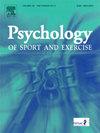Determinants of physical activity adoption and maintenance in older adults: A dual process approach
IF 3.1
2区 心理学
Q2 HOSPITALITY, LEISURE, SPORT & TOURISM
引用次数: 0
Abstract
Background
Dual process models represent a useful framework for explaining physical activity (PA) in that behavior is explained by reflective (i.e., conscious, effortful) and automatic (i.e., unconscious, effortless) determinants. Yet the distinct momentary reflective and automatic determinants associated with PA adoption and maintenance are unclear.
Methods
Older adults (N = 202; ≥60 years) wore accelerometers to measure PA (i.e., moderate to vigorous intensity PA [MVPA], step counts) and completed brief mobile phone prompts assessing general reflective (i.e., demands, deliberation, self-efficacy, self-control, stress coping, emotion regulation), behavior-specific reflective (i.e., PA intentions, self-efficacy, planning), and automatic determinants (i.e., affect, physical and social context, functional stability of one’s routine) as part of three, 2-week waves of data collection spaced over one year. Multilevel modeling was used to examine the within- and between-person associations between these determinants and subsequent PA.
Results
There were within- or between-person differences between general reflective, behavior specific, and automatic determinants and PA by adopter and maintainer status. General reflective determinants tended to be more predictive of step counts compared to MVPA. Within-person behavior-specific reflective determinants (i.e., intentions, self-efficacy, plans) were positively associated with PA behavior but associations tended to be more positive among PA maintainers. Automatic determinants were more predictive of the amount of PA as opposed to the likelihood of PA occurring.
Conclusion
Reflective and automatic determinants, as well as the levels at which these determinants operate (i.e., between vs within), need to be considered when attempting to explain and predict the adoption and maintenance of PA.
老年人采用和保持体育锻炼的决定因素:双重过程法
背景:双过程模型代表了一个解释PA的有用框架,因为行为是通过反思(即有意识的,努力的)和自动(即无意识的,不努力的)决定因素来解释的。然而,调节PA采用和维持的明显的瞬时反射和自动决定因素尚不清楚。方法:老年人(N = 202;≥60岁)佩戴加速度计测量PA(即中高强度PA [MVPA],步数),并完成简短的手机提示,评估一般反射(即需求,深思,自我效能,自我控制,压力应对,情绪调节),特定行为反射(即PA意图,自我效能,计划)和自动决定因素(即情感,身体和社会环境,日常功能稳定性)作为第三部分。数据收集周期为两周,间隔超过一年。多层模型被用来检查这些决定因素和随后的PA之间的人内部和人之间的关联。结果:一般反思性、行为特异性和自动决定因素与收养者和维持者状态之间存在人内或人之间的差异。与MVPA相比,一般反射决定因素往往更能预测步数。个人行为特定的反思决定因素(即意图、自我效能、计划)与PA行为呈正相关,但PA维持者之间的关联更为积极。与PA发生的可能性相反,自动决定因素更能预测PA的数量。结论:在试图解释和预测PA的采用和维持时,需要考虑反射和自动决定因素,以及这些决定因素运作的水平(即,在之间vs内部)。
本文章由计算机程序翻译,如有差异,请以英文原文为准。
求助全文
约1分钟内获得全文
求助全文
来源期刊
CiteScore
6.40
自引率
5.90%
发文量
172
审稿时长
69 days
期刊介绍:
Psychology of Sport and Exercise is an international forum for scholarly reports in the psychology of sport and exercise, broadly defined. The journal is open to the use of diverse methodological approaches. Manuscripts that will be considered for publication will present results from high quality empirical research, systematic reviews, meta-analyses, commentaries concerning already published PSE papers or topics of general interest for PSE readers, protocol papers for trials, and reports of professional practice (which will need to demonstrate academic rigour and go beyond mere description). The CONSORT guidelines consort-statement need to be followed for protocol papers for trials; authors should present a flow diagramme and attach with their cover letter the CONSORT checklist. For meta-analysis, the PRISMA prisma-statement guidelines should be followed; authors should present a flow diagramme and attach with their cover letter the PRISMA checklist. For systematic reviews it is recommended that the PRISMA guidelines are followed, although it is not compulsory. Authors interested in submitting replications of published studies need to contact the Editors-in-Chief before they start their replication. We are not interested in manuscripts that aim to test the psychometric properties of an existing scale from English to another language, unless new validation methods are used which address previously unanswered research questions.

 求助内容:
求助内容: 应助结果提醒方式:
应助结果提醒方式:


